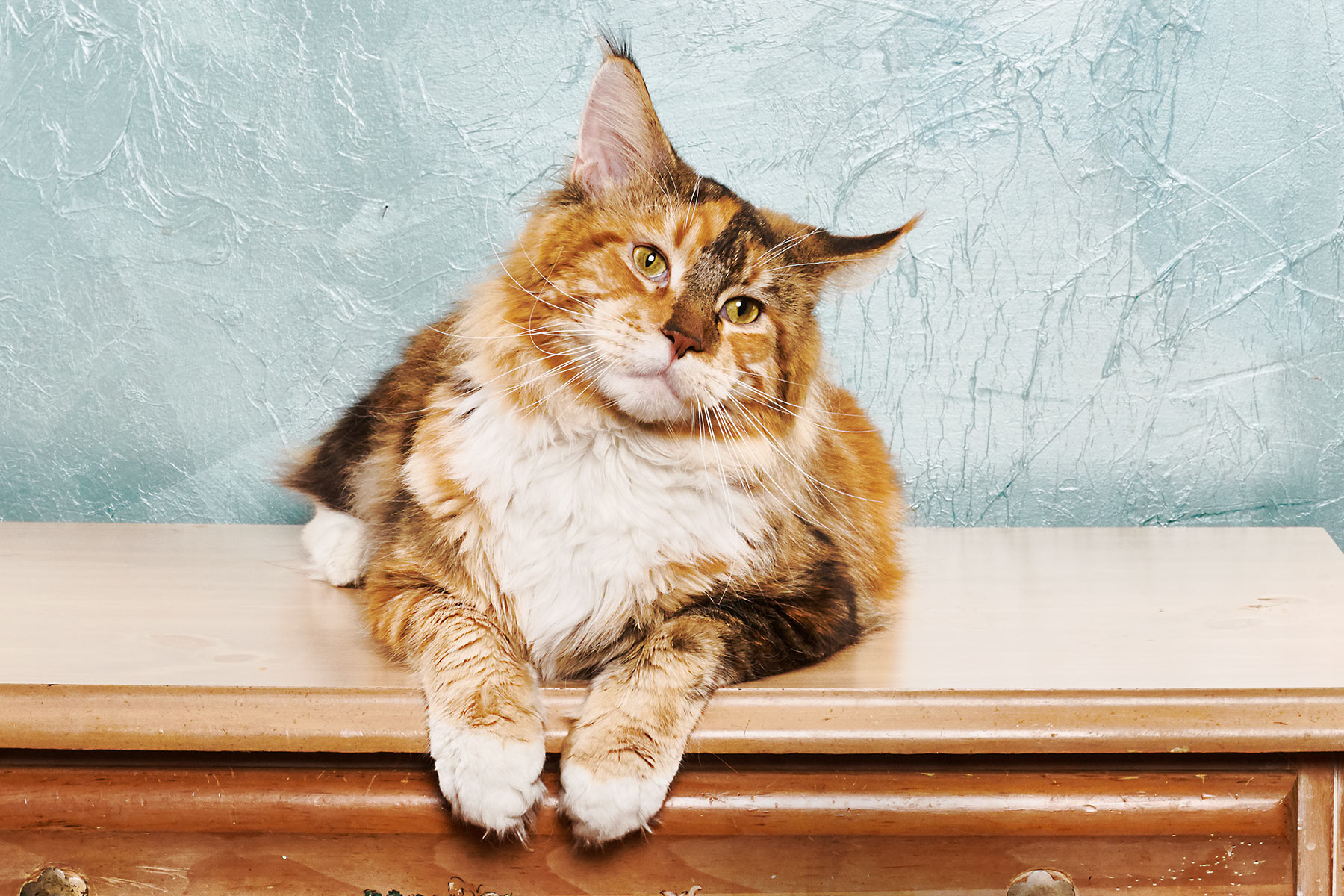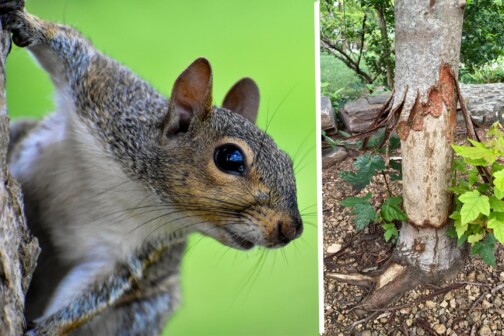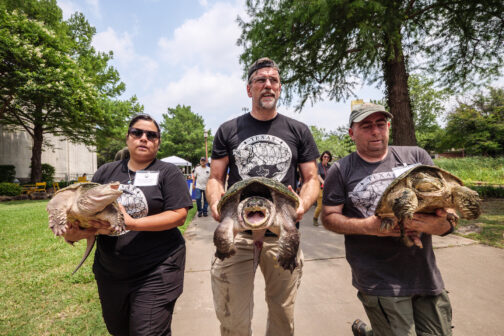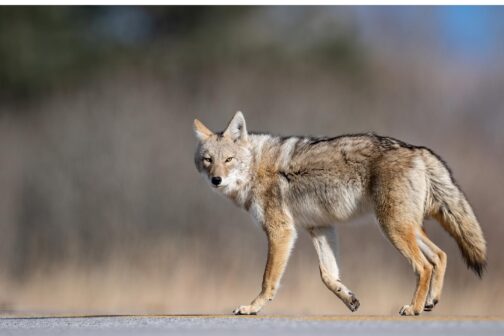For the most part, it’s business as usual inside the mustard-walled banquet room of the Hampton Inn & Suites in Mesquite, where nearly 160 purebreds are prepping for The Cat Fanciers’ Association Allbreed Cat Show, hosted by the North Texas and Fort Worth Cat Clubs. There’s an American bobtail from San Diego, a Russian Blue from Houston, and a Siamese from Ontario. But all eyes are on Reynah, a Burmilla from Northern California here to defend her position as the CFA’s best cat.
Vendors man displays of cat trees, cat mats, feather wands, and t-shirts bedazzled with the words “Crazy Cat Lady.” In one of the six show rings, a judge lifts a Turkish Van and stretches its body before the audience to prove the animal is, as it should be, “built like Michael Phelps.”
I tell the people behind a registration table that I’m from D Magazine and ask where I might find an exhibitor by the name of Mistelle Stevenson.
“Oh, you’re probably here because of the calico,” says a gentleman with a helmet of silver hair, who I find out later is Mike Altschul, one of the weekend’s show managers. “Yeah, we weren’t too happy about that. She’s somewhere over there.” He flicks his hand toward a back corner. As I turn and start to walk away, he bellows after me, “You know, we don’t let three-legged cats in here either!”
I should have known then that I was stepping into some deep and dirty kitty litter.
The whole controversy started last December when Stevenson entered a Maine coon by the name of Dawntreader Texas Calboy in The Cat Fanciers’ Association show in Cleburne. As the cat’s name implies, he is a calico—marked with patches of brown, red, and white—and he is male. Those things do not go together. The basics of feline genetics say calicos are supposed to be female. (“Technically almost genetically impossible,” one Dallas veterinarian told NBC 5.) The judges had no idea what to do with him. The CFA’s inches-thick book of rules didn’t list his color for male cats. Confusion ensued.
Some of the judges held Calboy up to the crowd, praised his lovely form, then gawked over his coloring and promptly kicked him out of their show rings. Others awarded him ribbons. Despite the judges’ disagreement, by the end of his Cleburne weekend, Calboy had accumulated four wins. Two more and he’d be a champion.
“So we’re not discriminating,” Mike Altschul says. “We’re just saying it’s a genetic anomaly that we don’t normally see, and it’s not in the show rules.”
Stevenson decided to pack up Calboy and head to the January show in Houston. But by then, word had spread about the questionable cat. Most of the judges wouldn’t allow Calboy to compete due to his gender-defying mottled markings. Still, one broke from the crowd to give him a win. With one more, he’d have enough points to become the first male calico champion in CFA history.
Then, before Calboy had another chance to compete, a sweeping addendum was made to Show Rule No. 30.01 at the CFA’s annual board meeting in February, officially making all “male cats whose color combinations occur only by virtue of genetic anomaly” ineligible from winning titles. Calboy was officially out of the competition. Stevenson was devastated. NBC 5 ran a story, which was quickly picked up by several outlets, including Newsweek. That was why, when I asked Stevenson if I could meet her at the Mesquite show in April, she said she’d be happy to talk, but Calboy would not be present. The climate was “a bit hostile.”
Standing in the Mesquite show hall in the presence of Mike Altschul, I realize her barometric reading is spot on. He’s a member of several North Texas cat clubs and produces four cat shows a year. He’s also the co-owner of Valentino, a Persian as white and voluminous as a cumulus cloud and this season’s only double national winner. As we speak, Valentino is resting in Altschul’s arms, wearing a bib and “making biscuits.” That is, kneading.
Altschul seems concerned that Stevenson is new to The Cat Fanciers’ Association, having previously shown cats in the more liberal TICA, The International Cat Association. The inclusive TICA, formed in 1979, recognizes 71 breeds to the CFA’s 42, including the controversial short-limbed Munchkin cat and felines of Calboy’s color (he’s a TICA triple Grand Champion). The CFA has been a conservative organization since its start in 1906.
If Stevenson wants to change the CFA rules to allow for a genetic anomaly, Altschul says, then there is a process. Going to the press is not part of that process. “Reverse publicity” is what he calls the news story. “This show hall is full of breeds and colors that didn’t used to be recognized,” he says. “So it’s a little misleading, a lot of her reports. They just irritate me, because it sounds negative.”
He leaves Valentino at his station and whisks me to a makeshift office in a corner where the rule book is kept. He points to a page to show that there is no rule number for Calboy, because cats of his color are “not supposed to come in male.” “So we’re not discriminating,” he says. “We’re just saying it’s a genetic anomaly that we don’t normally see, and it’s not in the show rules.”
He suggests that Stevenson’s efforts would be better spent applying to join a CFA breed council. These are the groups within the association that define the standards for their given breed, deciding the preferable shape of the eyes or width of the ears or the point values given to the coat and body type.
“So what I’m saying is that there is an avenue for her to pursue,” he says, growing increasingly agitated as he ticks off requirements like it’s an application for Harvard med school. He suddenly stops to pull a wadded tissue from his pocket.
“I think my nose is about to bleed.”
“So she needs to join the breed council,” I try to clarify, “but to do that you have to—”
“Show them enough. To be experienced!” he says through the tissue. “We’re not going to allow new people to control what’s going on!”
Altschul walks away, but he’s made his point. A gauntlet has been thrown.
Mistelle Stevenson was a little girl on her grandfather’s farm in Minnesota the first time she saw a Maine coon. “The cat was almost as big as I was,” says Stevenson. “Or at least it felt like it.” Years later, as an adult, she remembered that moment when she came across one at an animal shelter, a purebred whose owner had passed away. Her husband, Robby, is more of a dog person, but Maine coons are known as the dogs of the cat world. They can be taught to play fetch and they’re known to greet their humans at the door much like man’s best friend. The couple fell in love.
Mistelle started thinking about breeding when she heard about a movement to bring back polydactyl Maine coons, those born with extra toes, a trait that helped the native cats trek the forests of Maine. (Not surprisingly, CFA does not recognize bonus toes.) The Stevensons opened their cattery in 2012, naming it Dawntreader after the ship in the fifth Chronicles of Narnia book.
For her full-time gig, Mistelle works as a recovery nurse, specializing in critical care, at Methodist Dallas Medical Center. Robby is a policeman in DeSoto who’s been working with some buddies to start a nonprofit for officers with mental health issues. They live in Waxahachie, about 30 miles south of downtown Dallas, and their 3-acre property is home to four kids, four dogs, six pigs, 16 cats, a goose named Mr. Goosington, and, oftentimes, a neighbor’s peacock that’s taken a liking to their yard.
Since opening the cattery, they’ve bred 30 litters of kittens, with three to four kittens per litter, each feline going for $1,500. Still, it’s a hobby, not a moneymaker. Robby gave up his garage so they could close it in and add HVAC, wood floors, and cat trees. They also knocked out a wall for French doors to join the “kitten room” with their master suite. The plumber recently came out to reroute some pipes for a stainless steel cat-bathing tub. Then there are food and medical expenses—not just vet visits but also the cost of echocardiograms to check for a heart disease common among Maine coons.
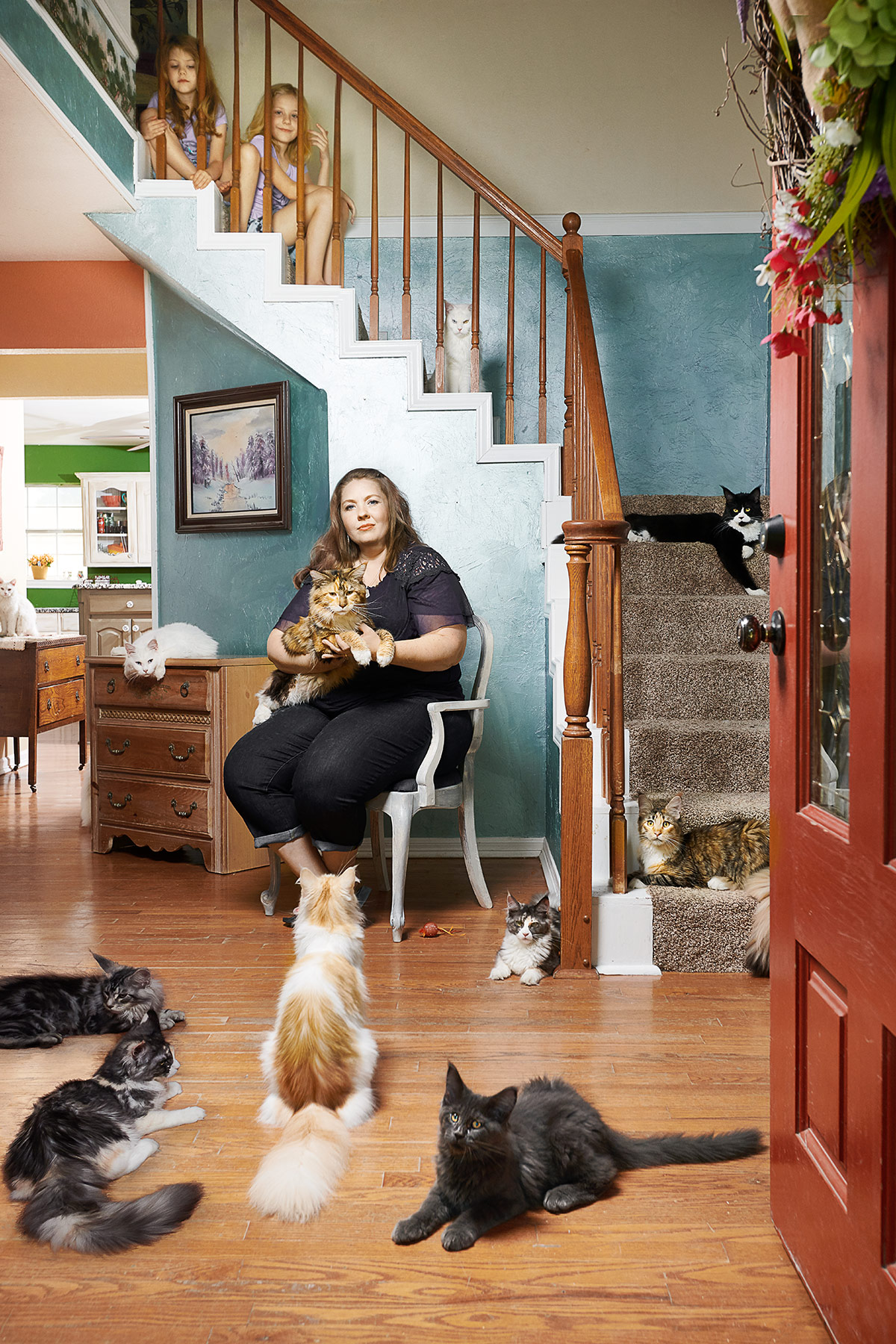
There’s also the cost of travel to cat shows. Spending a weekend among fellow cat enthusiasts is fun, but for those who run a cattery, it’s important for a few reasons: it shows you’re serious about your program and not a backyard breeder hawking inbred felines or unsafely experimenting with genetics and, say, cooking up teacup kitties that end up having health problems. It allows you to network and keep up with best practices. Plus, winning titles in the Champion class (the one that allows unneutered or unspayed cats) is good for business. It’s prestigious. People seek out kittens from Champions.
Stevenson had a few years of breeding under her belt when she delivered a small litter on January 5, 2017, at 2 in the morning. Sadly, one of the kittens didn’t make it, but over the weeks, a sweet little calico showed promise. Both the kitten’s dam (mom) and sire (dad) were well-pedigreed and had lineage going back to Heidi Ho, a famous Maine coon cattery started in the 1960s. After evaluating the calico, its temperament and features, the Stevensons decided it would be a show cat. Their evaluation missed something, however.
The bit and pieces on the tail end of a brand-new kitten are small, and not even the best of breeders can identify the sex early on. But the Stevensons assumed, as any breeder would, that the calico was a female. Like humans, female felines have XX chromosomes and males have XY. Unlike humans, cats have fur that comes in shades of either red or black, and color is a trait linked to the X chromosome. So, naturally, if you breed an orange cat and a black cat, the XX females might pop out with patches of both hues, but the male, having just one X, would only inherit the color passed from his mom. Since the calico had brown, red, and white markings, they assumed it was a “she.”
“I lifted up the tail and I realized—that wasn’t a knot,” Mistelle Stevenson says. “That was a shock.”
It wasn’t until the calico was 12 weeks old, going in for its second vet visit, that Stevenson felt a knot on the kitten’s leg. “I lifted up the tail and I realized—that wasn’t a knot,” she says. “It was shocking.” The vet did a double take before trotting the kitten around the clinic to show his colleagues. The feline was christened Dawntreader Texas Calboy. (Breeders use the name of their cattery as a prefix on their cats’ names.)
In Stevenson’s research, she learned that in the rare case of a male calico, it usually has Klinefelter’s syndrome, a chromosomal makeup of XXY that renders the cat sterile. Stevenson keeps her fertile males separated from the females, but since Calboy was young and infertile, she let him run free throughout their house. Then, at just over 7 months old, Calboy proved to be a stud. “I had all these females all of a sudden that were pinked up,” Stevenson says. “Thankfully, he did not get to his mom or grandma.”
When the kittens arrived, their colors were all over the place. She wondered if maybe one of the kids let a male out of its room. There was only one way to know for sure. She swabbed the inside of Calboy’s cheek and sent it off to the Veterinary Genetics Laboratory at the University of California, Davis for testing, along with samples from two different colored kittens. They told her the sample was contaminated; Calboy’s results showed two cats. She tried swabbing again, this time videotaping the process to prove the sample was uncontaminated. Again, the lab work showed two sets of DNA. Seeing that the variants on the genes were exactly the same, the lab was able to confirm: Calboy was a chimera.
Sometime early on in utero, two embryos that would normally develop into two different cats, each with its own set of DNA, fused together and grew into one cat. This does not mean Calboy is a hermaphrodite; he doesn’t have any other extra organs or body parts. It means he’s a kitty cocktail carrying two kinds of DNA. Some of his cells carry one cat’s set, some the other.
“I call it an embryonic accident by development,” says Dr. Cecilia Penedo, the associate director of the lab at UC Davis. The lab has researched a few thousand cases so far this year and come across three cases of chimerism, Calboy and two dogs. Penedo notes that chimerism is not a heritable condition. The lab also studied samples from two of Calboy’s kittens and they appeared to be normal. Penedo does not consider chimerism to be a genetic defect. “In this particular case,” she says, “it’s just an unusual event.”
If there’s anything telling of cat fancy politics, it’s the history of the Maine coon. The breed is thought to be the only longhaired domestic cat native to North America, and its origin story is full of folklore. There’s the one about a cat having a rendezvous with a raccoon (not possible), a cat and a bobcat (maybe), coming over on Viking ships (likely), Marie Antoinette sending her longhaired felines off to the United States before the revolution claimed her head (a mostly true story, but no one knows what kind of cats rode that vessel), and another about a British seaman named Charles Coon whose boatful of cats sowed their wild oats at each port along the East Coast. But the simple, Darwinistic theory—that there were cats for hundreds of years that adapted to rough conditions of the Northeast by growing thick coats and large paws—is the safest assumption.
All of this to say, Maine coons are probably even more American than apple pie and baseball; more like maize and lacrosse. And for a while, Americans adored their indigenous breed. It was Cosey the Maine coon that won the first major U.S. cat show at Madison Square Garden in 1895. But by the time the CFA was founded, in 1906, Maine coons were going out of fashion. Plush new European imports began arriving, and, with them, the concept of cat as status symbol. Finally, in 1968, after decades of declining numbers, a group of enthusiasts formed the Maine Coon Breeders and Fanciers Association to resuscitate the breed and get it in the show hall. Even then, it took eight long years of working with the CFA’s board of directors, getting provisional status denied three times, before the Maine coon finally got its due as a competitive show breed.
(It should be noted that the breed’s popularity has grown significantly since the ’70s. Maine coons have been one of the most-registered breeds in the CFA since the ’90s. And, in 2004, a North Texas woman so loved her Maine coon that she paid $50,000 to an ironically short-lived venture called Genetic Savings & Clone, resulting in the first known commercially cloned cat.)
So if it took the CFA seven decades to recognize its homegrown hero, the feline that served as both an affectionate companion and an excellent mouser to so many early Americans, allowing Calboy and his unconventional coloring may be a long battle. His kind might be recognized one day, but it could very well happen over his dead body.
The CFA is proud of this conservative approach, but the bureaucracy can be head-spinning. Kathy Black, the director of the CFA’s Gulf Shore region, says the problem with Calboy was that even though the CFA has never allowed “female-colored males” to compete for titles, his specific coloring was mistakenly not included on the list of colors that disqualify males.
Like Altschul, Black says that if Stevenson feels strongly about the CFA allowing female colors on a male cat, there are steps she can take. She can join her local cat club, get them to submit a proposal for a vote at their annual meeting, an event attended by more than 600 delegates from around the world. If it passes the delegation, it would then be presented to the board of directors for ratification. But, if it’s passed by two-thirds of the delegates, it is approved without the board’s say-so.
Yet, as Stevenson points out, the board had the opportunity at the February meeting to vote in favor of allowing Calboy to compete, and they didn’t. Stevenson also notes that judges are disqualifying Calboy’s color, which is due to a genetic anomaly—chimerism. Plenty of female chimeras could be passing through the shows and no one knows because their color isn’t unusual. As for joining her local cat club, that would put her in the company of people like Altschul, who didn’t exactly roll out the welcome wagon. Remember that he compared her calico to a three-legged cat.
And really, that’s the biggest hurdle. She can’t change the rules until she can change the way people view Calboy’s coat. “There were some people who felt very strongly about him showing as a boy in girls clothes,” she says. Between rings at the Houston CFA show, one of the judges asked Stevenson what she would do if breeding Calboy produced another “transvestite male.” Stevenson looked him in the eye and said, “What if he does? Wouldn’t that be absolutely amazing?”
As it turns out, Calboy wasn’t the first male calico in CFA show rings. Stevenson heard about a cat in the ’90s named Pretty Boy Floid owned by Nancy and Rich Koch out in Washington. A Seattle Times story described a fairly glowing picture of Floid’s presence at cat shows. Crowds gathered as the kitty “would come out of his cage and lay down in a Burt Reynolds pose on his side and allow everyone to take their best shots.”
I called the Kochs early one morning in May and spoke with Nancy. Their experience mirrored Stevenson’s. The couple initially named the kitten Betsy Ross (he was red, white, and blue) before realizing he was a Pretty Boy.
Once they started entering him in CFA shows, Nancy says she felt like one of the breed secretaries had a vendetta against Floid. “There were some associations that pretty much shunned him because he was an abomination,” Nancy says. “He didn’t fit the buckets that everybody had to fit into. He was the perfect type and everything, but just because of the paint palette on his back. It was pretty crazy.”
The Kochs eventually traded in cat shows for car shows, a pastime Nancy says is less expensive and “more sedate.” “The whole philosophy with CFA is perfection of the breed, and anything that doesn’t fit perfection is not acceptable,” Nancy says. “And I can understand that, but I would like to have a little appreciation for things that are good but may be a little different. I guess maybe that is a statement about what the whole world’s like these days.”
When Stevenson comes to her door, she’s wearing one of those “Crazy Cat Lady” tees. She keeps a firm grip on Calboy as we talk to keep him from the females in heat. His kittens are skittering about, one literally climbing the wall as she discusses Calboy’s plight. At this point, even the greatest of cat lovers might wonder, Why does this lady care so much about showing her cat? Is she as crazy as the rhinestones on her shirt say she is?
Part of it, I think, is just that Calboy is a fantastic show cat. He can easily withstand the rigorous “show bath”—a five-step process that involves a degreaser called Groomer’s Goop, Dawn dish soap, shampoo, conditioner, and a thickening product. Traveling with him is no problem; he’s never gotten sick. He likes to meet new people on the road, giving head bumps and kisses. And he’s a natural at the shows, reveling in the attention and stretching out for the judges. “If I left his door open, he’d prance around the show hall,” Stevenson says.
“Allow him to be himself and be what he was born to be,” Stevenson says. “If the color is allowed for a female, it should be allowed for a male. Just judge him based on the standard and not on his sex.”
And, of course, he has the look. The Maine coon breed standard specifies a long and rectangular body, a square muzzle, ears set wide apart, and oval eyes, among other traits. He’s slightly above the normal size scale, just shy of 20 pounds, but weight isn’t defined in the standards. So really, Calboy checks all the boxes. All, of course, except for his color.
But an hour into our conversation, I realize there’s another reason Stevenson isn’t letting this go. And then I get it. In fact, I get it so much, tears start rolling down my face—and it’s not just because I’m mildly allergic to cats. It has to do with Stevenson’s oldest son. He’s autistic. “A 12-year-old in an 18-year-old’s body,” she explains. The way people react to Calboy, it’s the same way people look at her son when they realize the teenager in front of them isn’t what they expect.
Having a sister with special needs, I know how it can change you. People want to know how it happened. She had her first seizure at 18 months; we don’t know why. You have to explain their condition. She’s high-functioning, but she’ll never live on her own. Sometimes you explain why they’re so great, despite their needs. She has such a big heart. Sometimes this feels like you’re justifying their existence.
So I get it. Stevenson has been advocating for her son for 18 years, and then along comes this cat. She felt like judges were publicly humiliating Calboy as they discussed his color in front of spectators. “What happens with our family members is we try to protect them,” she says. “If my son had been ridiculed up there in the ring, I wouldn’t have stood for it.”
All she asks for is the opportunity for Calboy to compete. “My husband and I feel like he’s a miracle. That he’s fearfully and wonderfully made, and that it’s OK for a male to look like a girl,” Stevenson says. “Allow him to be himself and be what he was born to be. If the color is allowed for a female, it should be allowed for a male. Just judge him based on the standard and not on his sex.
“I hope that—” Stevenson’s voice breaks as she speaks through tears. “I hope that with each person that Calboy wins over, people find that they can be a little bit more accepting, you know? And a little bit kinder. If he doesn’t win in the ring, he can win in their hearts. He can win.”
For now, Stevenson is leaving Calboy at home when she goes to CFA shows. But the special cat has his fans. On August 18, Calboy will make an appearance at Dallas’ Cat Connection cat cafe, a venue that doesn’t discriminate. Chimeras and three-legged felines welcome.
Get the D Brief Newsletter
Author



